MAZDA MODEL TRIBUTE 2011 Owners Manual (in English)
Manufacturer: MAZDA, Model Year: 2011, Model line: MODEL TRIBUTE, Model: MAZDA MODEL TRIBUTE 2011Pages: 320, PDF Size: 2.08 MB
Page 231 of 320

5. Use the lug wrench to remove
the lug nut from the spare tire
tether.
6. If not replacing the spare or flat
tire to the underbody storage
area, raise winch up into the
installed position.
7. Use the attached fastener strap
(2) to tie the tether end to the
winch actuator shaft (if
equipped).
Tire change procedure
WARNING:When one of the front wheels is off the ground, the
transmission alone will not prevent the vehicle from moving or
slipping off the jack, even if the vehicle is in P (Park) (automatic
transmission) or R (Reverse) (manual transmission).
WARNING:To prevent the vehicle from moving when you
change a tire, be sure the parking brake is set, then block both
sides of the wheel that is diagonally opposite (other side and end of
the vehicle) to the tire being changed.
WARNING:Changing a tire is dangerous if not done properly. If
the vehicle slips off the jack, you or someone else could be
seriously injured. Be sure to follow the directions for changing a tire,
and never get under a vehicle that is supported only by a jack.
Roadside Emergencies
231
2011 Tribute(j14)
Owners Guide, 1st Printing
USA(fus)
Page 232 of 320
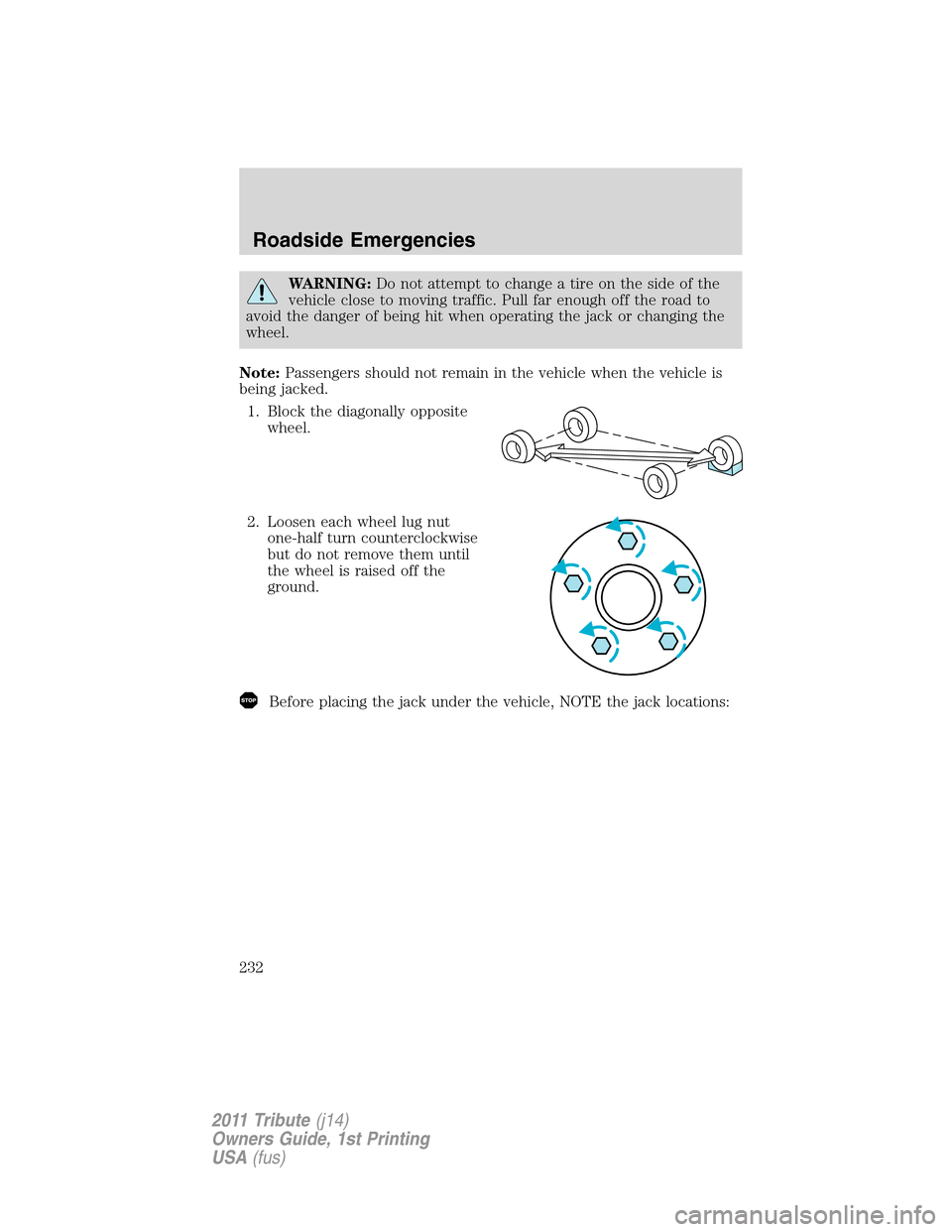
WARNING:Do not attempt to change a tire on the side of the
vehicle close to moving traffic. Pull far enough off the road to
avoid the danger of being hit when operating the jack or changing the
wheel.
Note:Passengers should not remain in the vehicle when the vehicle is
being jacked.
1. Block the diagonally opposite
wheel.
2. Loosen each wheel lug nut
one-half turn counterclockwise
but do not remove them until
the wheel is raised off the
ground.
Before placing the jack under the vehicle, NOTE the jack locations:
Roadside Emergencies
232
2011 Tribute(j14)
Owners Guide, 1st Printing
USA(fus)
Page 233 of 320
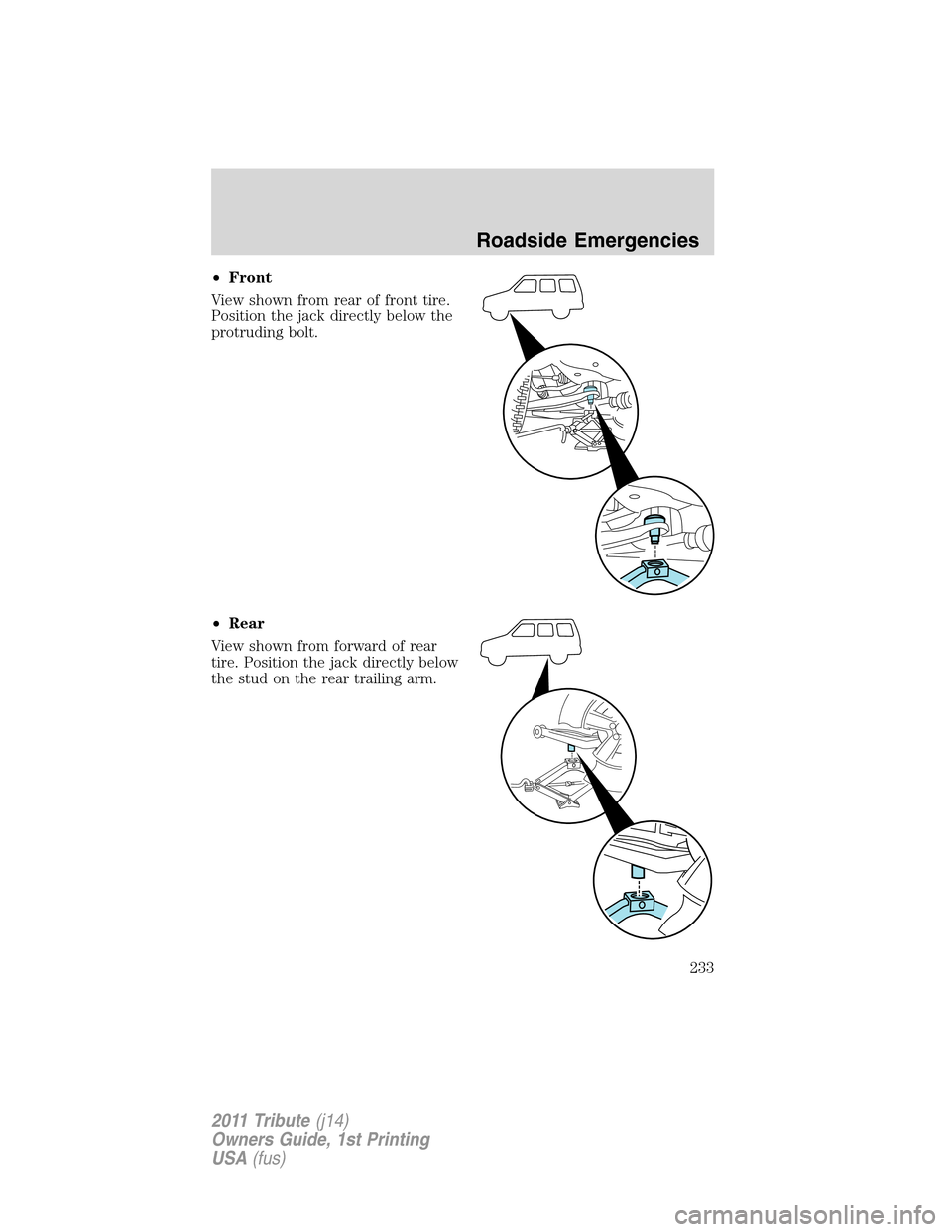
•Front
View shown from rear of front tire.
Position the jack directly below the
protruding bolt.
•Rear
View shown from forward of rear
tire. Position the jack directly below
the stud on the rear trailing arm.
Roadside Emergencies
233
2011 Tribute(j14)
Owners Guide, 1st Printing
USA(fus)
Page 234 of 320
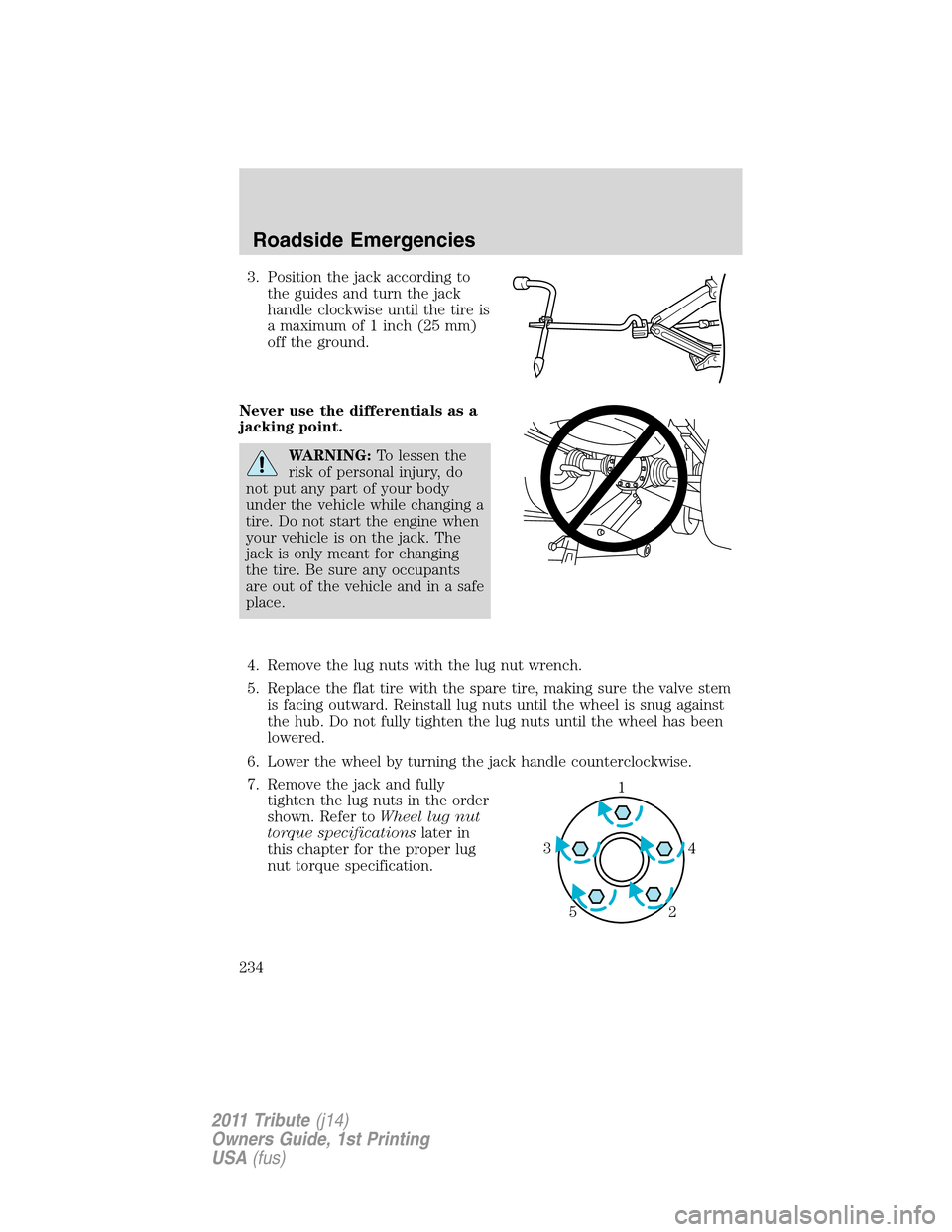
3. Position the jack according to
the guides and turn the jack
handle clockwise until the tire is
a maximum of 1 inch (25 mm)
off the ground.
Never use the differentials as a
jacking point.
WARNING:To lessen the
risk of personal injury, do
not put any part of your body
under the vehicle while changing a
tire. Do not start the engine when
your vehicle is on the jack. The
jack is only meant for changing
the tire. Be sure any occupants
are out of the vehicle and in a safe
place.
4. Remove the lug nuts with the lug nut wrench.
5. Replace the flat tire with the spare tire, making sure the valve stem
is facing outward. Reinstall lug nuts until the wheel is snug against
the hub. Do not fully tighten the lug nuts until the wheel has been
lowered.
6. Lower the wheel by turning the jack handle counterclockwise.
7. Remove the jack and fully
tighten the lug nuts in the order
shown. Refer toWheel lug nut
torque specificationslater in
this chapter for the proper lug
nut torque specification.
1
4 3
2 5
Roadside Emergencies
234
2011 Tribute(j14)
Owners Guide, 1st Printing
USA(fus)
Page 235 of 320

Stowing the jack and tools
•Make sure the jack is fully
lowered.
•Reclip the tools onto the jack
making sure that the tools are
fully contained by the clips as
shown.
•Reinstall the jack in the pocket
with the left side first, then snap
the right side down.
•Ensure that the hold-strap
contains the jack and tools before snapping the buckle.
•Ensure that the jack and tools are oriented as illustrated.
Stowing the flat/spare tire
Note:Failure to follow spare tire stowage instructions may result in
failure of cable or loss of spare tire.
If you are stowing a tire that requires reattaching it to the
vehicle with a tether, perform these steps first, then proceed with
the steps following.
1. Place tire on end with valve
stem facing rearward, away
from vehicle.
2. Place tether into bolt holes in
wheel and attach lug nut using
lug wrench.
3. Lay the tire on the ground with the valve stem facing down. If your
vehicle is equipped with aluminum wheels, remove the wheel center
cap.
4. Slide the wheel partially under the vehicle and install the retainer
through the center of the wheel.
5. Turn the jack handle clockwise until the tire is raised to its original
position underneath the vehicle. The effort to turn the jack handle
increases significantly as the tire contacts the frame. The spare tire
Roadside Emergencies
235
2011 Tribute(j14)
Owners Guide, 1st Printing
USA(fus)
Page 236 of 320
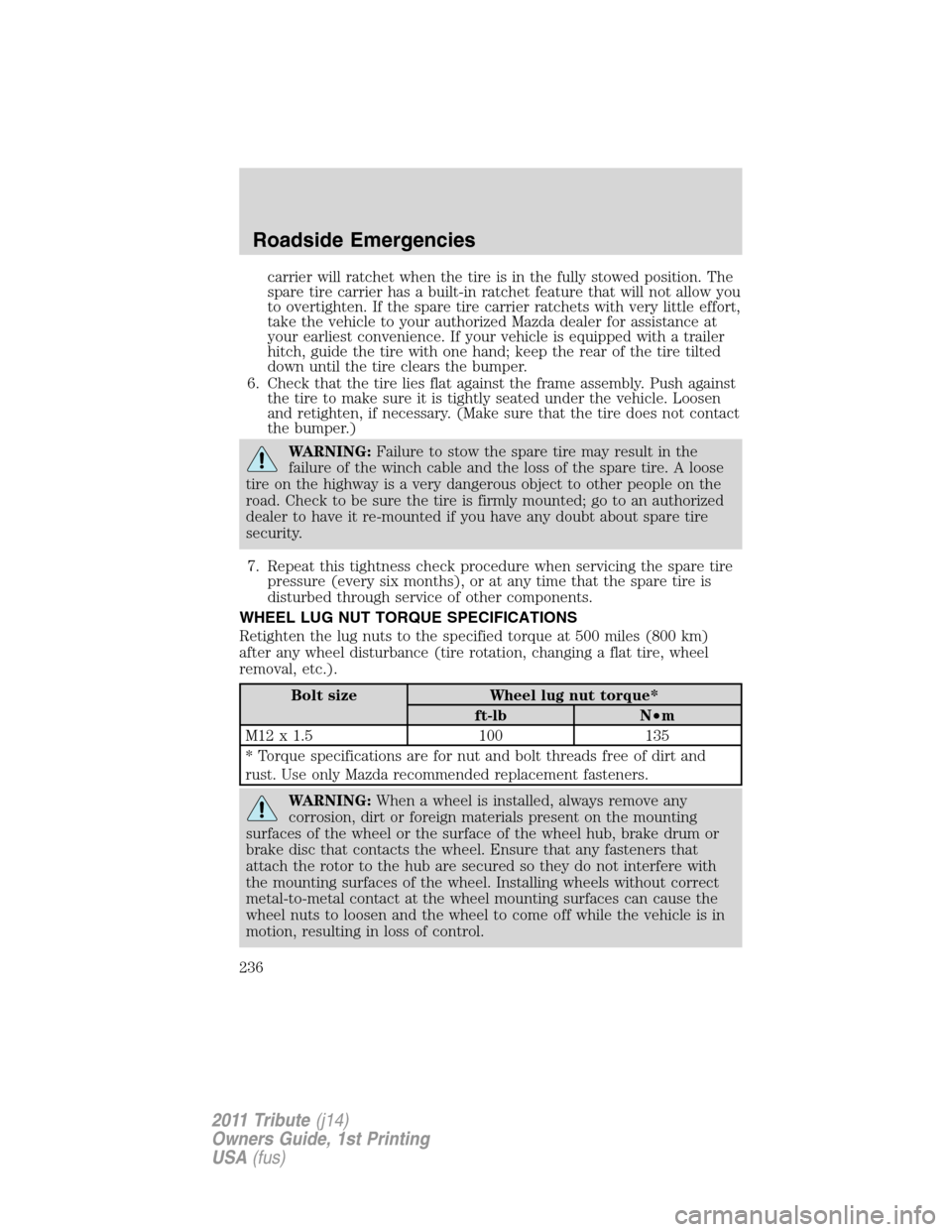
carrier will ratchet when the tire is in the fully stowed position. The
spare tire carrier has a built-in ratchet feature that will not allow you
to overtighten. If the spare tire carrier ratchets with very little effort,
take the vehicle to your authorized Mazda dealer for assistance at
your earliest convenience. If your vehicle is equipped with a trailer
hitch, guide the tire with one hand; keep the rear of the tire tilted
down until the tire clears the bumper.
6. Check that the tire lies flat against the frame assembly. Push against
the tire to make sure it is tightly seated under the vehicle. Loosen
and retighten, if necessary. (Make sure that the tire does not contact
the bumper.)
WARNING:Failure to stow the spare tire may result in the
failure of the winch cable and the loss of the spare tire. A loose
tire on the highway is a very dangerous object to other people on the
road. Check to be sure the tire is firmly mounted; go to an authorized
dealer to have it re-mounted if you have any doubt about spare tire
security.
7. Repeat this tightness check procedure when servicing the spare tire
pressure (every six months), or at any time that the spare tire is
disturbed through service of other components.
WHEEL LUG NUT TORQUE SPECIFICATIONS
Retighten the lug nuts to the specified torque at 500 miles (800 km)
after any wheel disturbance (tire rotation, changing a flat tire, wheel
removal, etc.).
Bolt size Wheel lug nut torque*
ft-lb N•m
M12 x 1.5 100 135
* Torque specifications are for nut and bolt threads free of dirt and
rust. Use only Mazda recommended replacement fasteners.
WARNING:When a wheel is installed, always remove any
corrosion, dirt or foreign materials present on the mounting
surfaces of the wheel or the surface of the wheel hub, brake drum or
brake disc that contacts the wheel. Ensure that any fasteners that
attach the rotor to the hub are secured so they do not interfere with
the mounting surfaces of the wheel. Installing wheels without correct
metal-to-metal contact at the wheel mounting surfaces can cause the
wheel nuts to loosen and the wheel to come off while the vehicle is in
motion, resulting in loss of control.
Roadside Emergencies
236
2011 Tribute(j14)
Owners Guide, 1st Printing
USA(fus)
Page 237 of 320
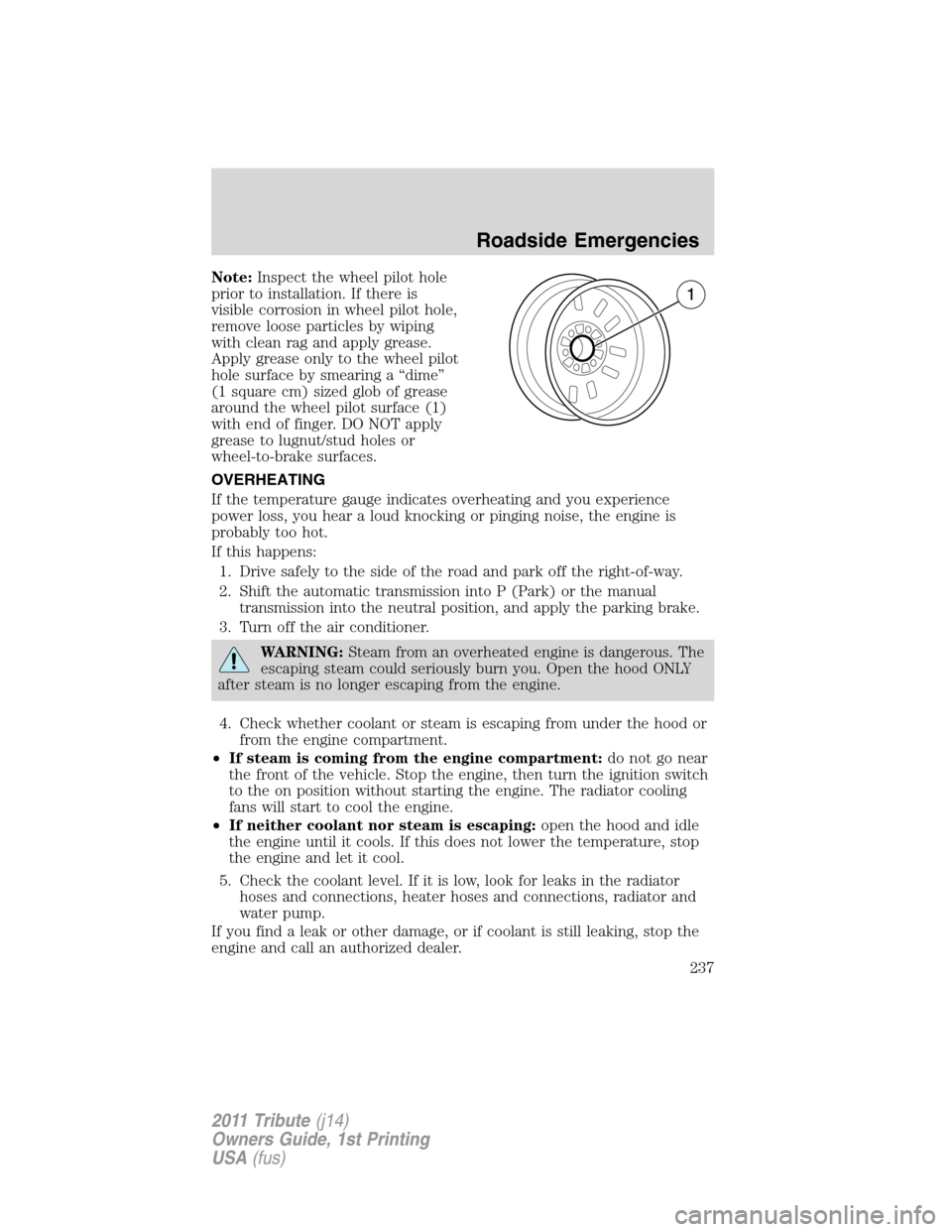
Note:Inspect the wheel pilot hole
prior to installation. If there is
visible corrosion in wheel pilot hole,
remove loose particles by wiping
with clean rag and apply grease.
Apply grease only to the wheel pilot
hole surface by smearing a “dime”
(1 square cm) sized glob of grease
around the wheel pilot surface (1)
with end of finger. DO NOT apply
grease to lugnut/stud holes or
wheel-to-brake surfaces.
OVERHEATING
If the temperature gauge indicates overheating and you experience
power loss, you hear a loud knocking or pinging noise, the engine is
probably too hot.
If this happens:
1. Drive safely to the side of the road and park off the right-of-way.
2. Shift the automatic transmission into P (Park) or the manual
transmission into the neutral position, and apply the parking brake.
3. Turn off the air conditioner.
WARNING:Steam from an overheated engine is dangerous. The
escaping steam could seriously burn you. Open the hood ONLY
after steam is no longer escaping from the engine.
4. Check whether coolant or steam is escaping from under the hood or
from the engine compartment.
•If steam is coming from the engine compartment:do not go near
the front of the vehicle. Stop the engine, then turn the ignition switch
to the on position without starting the engine. The radiator cooling
fans will start to cool the engine.
•If neither coolant nor steam is escaping:open the hood and idle
the engine until it cools. If this does not lower the temperature, stop
the engine and let it cool.
5. Check the coolant level. If it is low, look for leaks in the radiator
hoses and connections, heater hoses and connections, radiator and
water pump.
If you find a leak or other damage, or if coolant is still leaking, stop the
engine and call an authorized dealer.
Roadside Emergencies
237
2011 Tribute(j14)
Owners Guide, 1st Printing
USA(fus)
Page 238 of 320
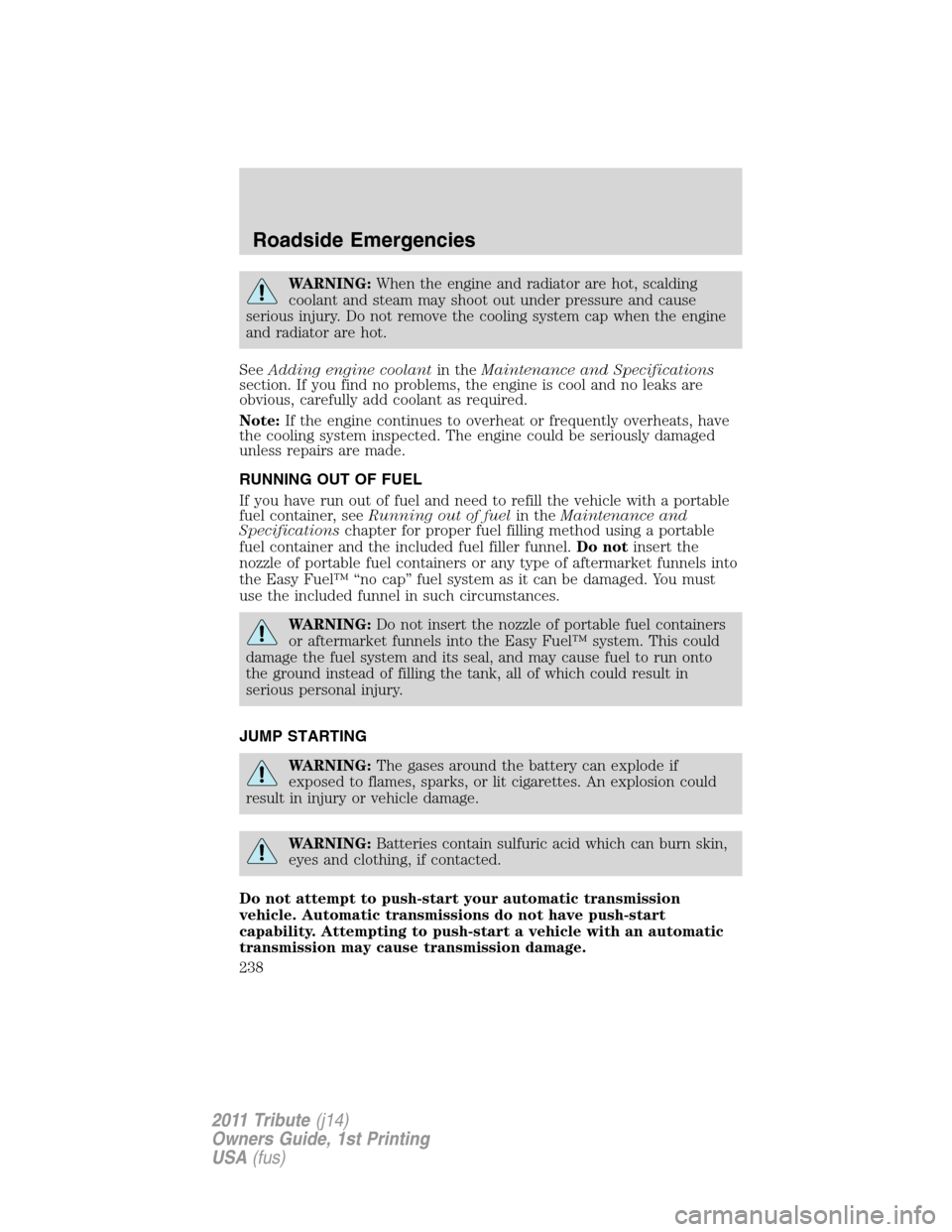
WARNING:When the engine and radiator are hot, scalding
coolant and steam may shoot out under pressure and cause
serious injury. Do not remove the cooling system cap when the engine
and radiator are hot.
SeeAdding engine coolantin theMaintenance and Specifications
section. If you find no problems, the engine is cool and no leaks are
obvious, carefully add coolant as required.
Note:If the engine continues to overheat or frequently overheats, have
the cooling system inspected. The engine could be seriously damaged
unless repairs are made.
RUNNING OUT OF FUEL
If you have run out of fuel and need to refill the vehicle with a portable
fuel container, seeRunning out of fuelin theMaintenance and
Specificationschapter for proper fuel filling method using a portable
fuel container and the included fuel filler funnel.Do notinsert the
nozzle of portable fuel containers or any type of aftermarket funnels into
the Easy Fuel™ “no cap” fuel system as it can be damaged. You must
use the included funnel in such circumstances.
WARNING:Do not insert the nozzle of portable fuel containers
or aftermarket funnels into the Easy Fuel™ system. This could
damage the fuel system and its seal, and may cause fuel to run onto
the ground instead of filling the tank, all of which could result in
serious personal injury.
JUMP STARTING
WARNING:The gases around the battery can explode if
exposed to flames, sparks, or lit cigarettes. An explosion could
result in injury or vehicle damage.
WARNING:Batteries contain sulfuric acid which can burn skin,
eyes and clothing, if contacted.
Do not attempt to push-start your automatic transmission
vehicle. Automatic transmissions do not have push-start
capability. Attempting to push-start a vehicle with an automatic
transmission may cause transmission damage.
Roadside Emergencies
238
2011 Tribute(j14)
Owners Guide, 1st Printing
USA(fus)
Page 239 of 320
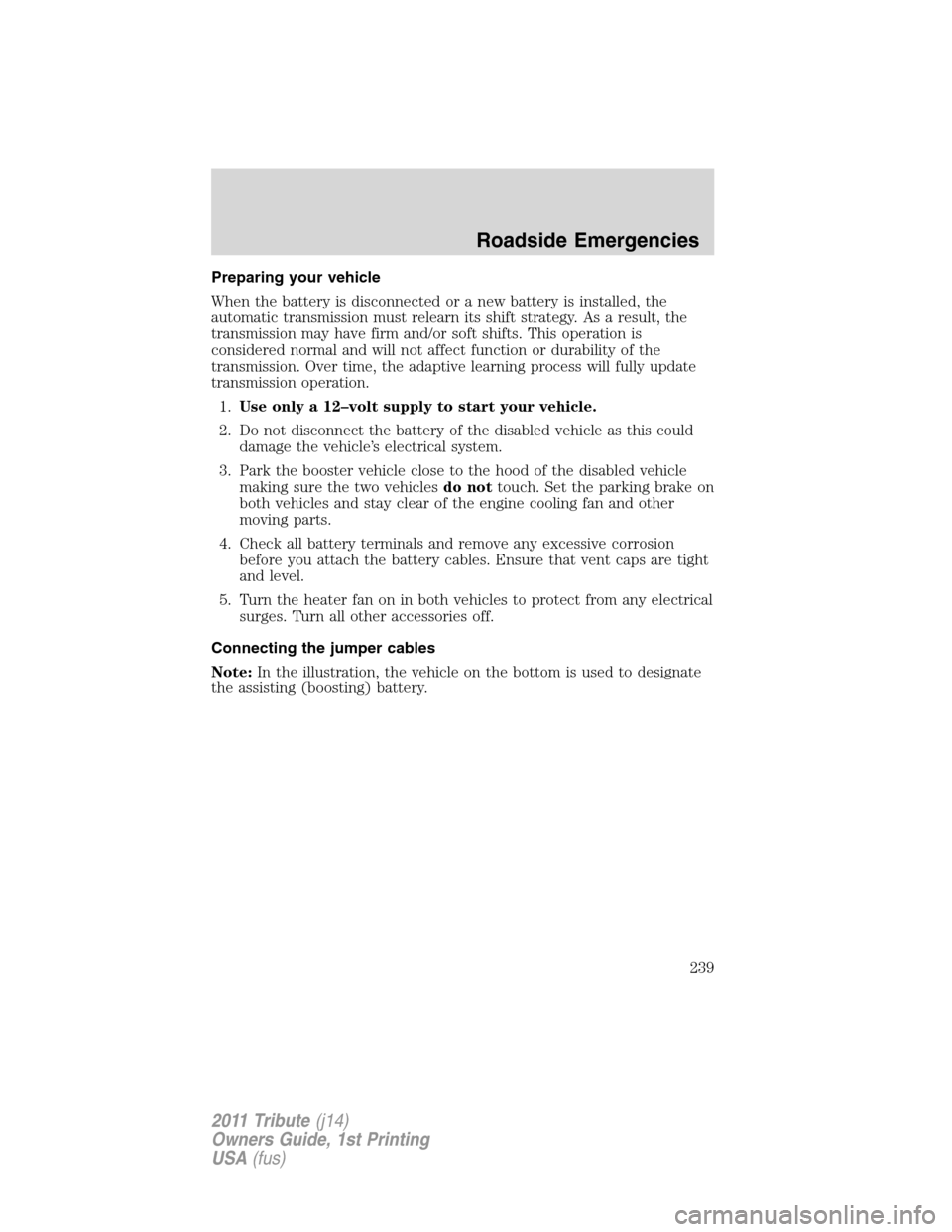
Preparing your vehicle
When the battery is disconnected or a new battery is installed, the
automatic transmission must relearn its shift strategy. As a result, the
transmission may have firm and/or soft shifts. This operation is
considered normal and will not affect function or durability of the
transmission. Over time, the adaptive learning process will fully update
transmission operation.
1.Use only a 12–volt supply to start your vehicle.
2. Do not disconnect the battery of the disabled vehicle as this could
damage the vehicle’s electrical system.
3. Park the booster vehicle close to the hood of the disabled vehicle
making sure the two vehiclesdo nottouch. Set the parking brake on
both vehicles and stay clear of the engine cooling fan and other
moving parts.
4. Check all battery terminals and remove any excessive corrosion
before you attach the battery cables. Ensure that vent caps are tight
and level.
5. Turn the heater fan on in both vehicles to protect from any electrical
surges. Turn all other accessories off.
Connecting the jumper cables
Note:In the illustration, the vehicle on the bottom is used to designate
the assisting (boosting) battery.
Roadside Emergencies
239
2011 Tribute(j14)
Owners Guide, 1st Printing
USA(fus)
Page 240 of 320
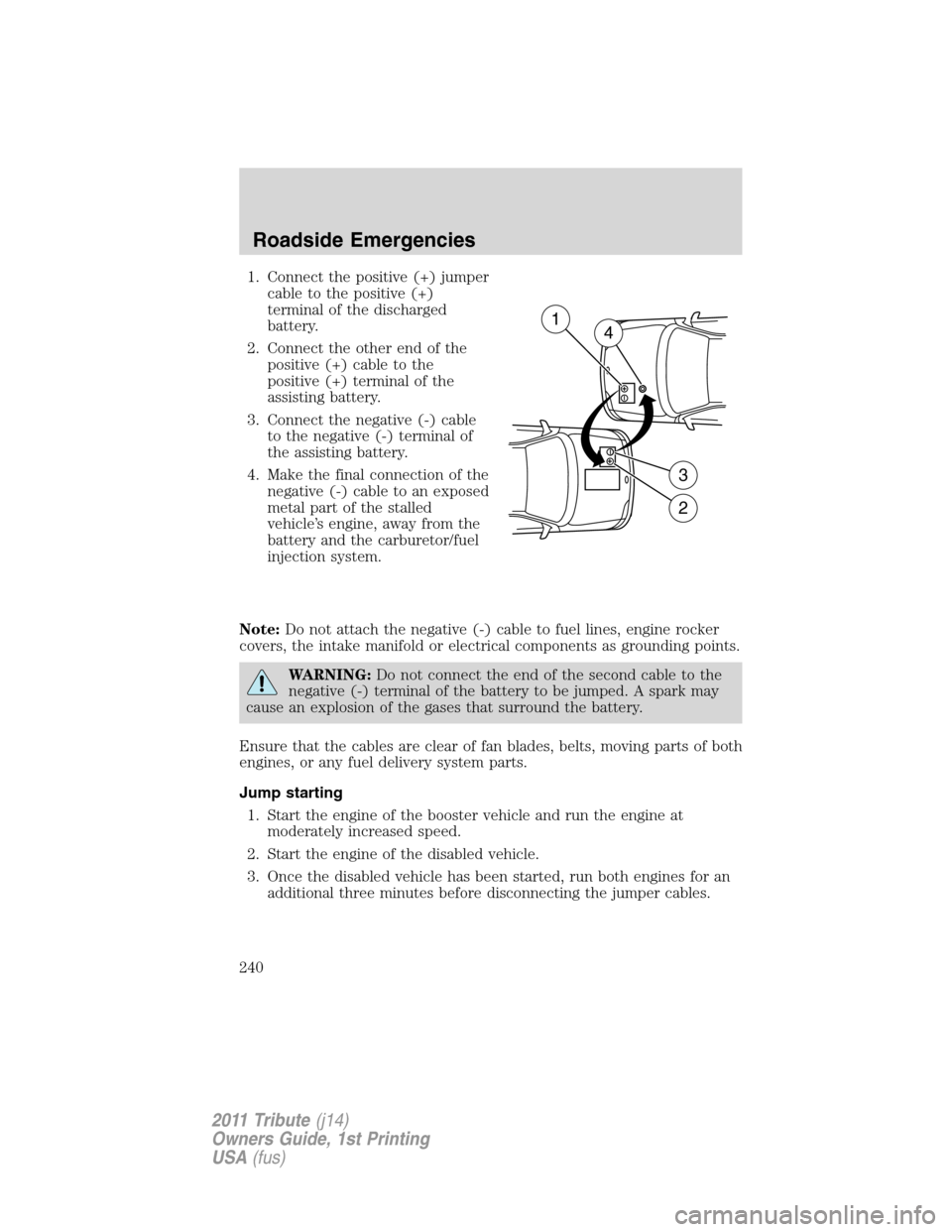
1. Connect the positive (+) jumper
cable to the positive (+)
terminal of the discharged
battery.
2. Connect the other end of the
positive (+) cable to the
positive (+) terminal of the
assisting battery.
3. Connect the negative (-) cable
to the negative (-) terminal of
the assisting battery.
4. Make the final connection of the
negative (-) cable to an exposed
metal part of the stalled
vehicle’s engine, away from the
battery and the carburetor/fuel
injection system.
Note:Do not attach the negative (-) cable to fuel lines, engine rocker
covers, the intake manifold or electrical components as grounding points.
WARNING:Do not connect the end of the second cable to the
negative (-) terminal of the battery to be jumped. A spark may
cause an explosion of the gases that surround the battery.
Ensure that the cables are clear of fan blades, belts, moving parts of both
engines, or any fuel delivery system parts.
Jump starting
1. Start the engine of the booster vehicle and run the engine at
moderately increased speed.
2. Start the engine of the disabled vehicle.
3. Once the disabled vehicle has been started, run both engines for an
additional three minutes before disconnecting the jumper cables.
+–
+–
2
3
14
Roadside Emergencies
240
2011 Tribute(j14)
Owners Guide, 1st Printing
USA(fus)